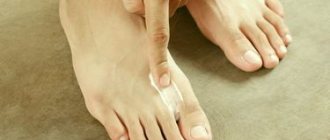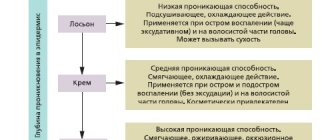Gistan-n 0.1% 15g cream for external use
pharmachologic effect
Glucocorticosteroid for local use.
Composition and release form Gistan-n 0.1% 15g cream for external use
1 g of cream contains:
- active substance: mometasone furoate – 0.001 g;
- excipients: liquid paraffin, soft white paraffin, propylene glycol, emulsion wax, sodium citrate, chlorocresol, cetomacrogol, water.
Cream for external use 0.1%.
5 g or 15 g of the drug in an aluminum tube.
1 tube per cardboard box along with instructions for use.
Description of the dosage form
White homogeneous cream for external use.
Directions for use and doses
Externally.
A thin layer of the drug is applied to the affected areas of the skin once a day.
Duration of treatment: 7-28 days, determined by the effectiveness of therapy, as well as the patient’s tolerability of the drug, the presence and severity of side effects.
Pharmacodynamics
Mometasone is a synthetic glucocorticosteroid (GCS). It has anti-inflammatory, antipruritic and antiexudative effects.
GCS induces the release of phospholipase A2 inhibitory proteins, collectively known as lipocortins, which control the biosynthesis of inflammatory mediators such as prostaglandins and leukotrienes by inhibiting the release of their common precursor, arachidonic acid.
Prevents the marginal accumulation of neutrophils, which reduces inflammatory exudate and cytokine production, inhibits the migration of macrophages, and leads to a decrease in the processes of infiltration and granulation. Reduces inflammation by reducing the formation of a chemotaxis substance (impact on “late” allergy reactions), inhibits the development of an “immediate” allergic reaction (due to inhibition of the production of arachidonic acid metabolites and a decrease in the release of inflammatory mediators from mast cells).
With daily application of the cream to children over 2 years of age with allergic dermatitis, the therapeutic effect appears within 3 weeks.
Pharmacokinetics
Absorption of Gistan-N cream is low. 8 hours after application to intact skin (without an occlusive dressing), about 0.4% of the dose is found in the systemic circulation. With inflammation and damage to the skin, absorption increases.
Indications for use Gistan-n 0.1% 15g cream for external use
Inflammation and itching of the skin in dermatoses (including psoriasis, atopic dermatitis, seborrheic dermatitis), for which GCS therapy is indicated.
Contraindications
- Hypersensitivity to any component of the drug or to other corticosteroids.
- Rosacea, perioral dermatitis.
- Bacterial, viral (Herpes simplex, chickenpox, Herpes zoster) or fungal skin infection.
- Tuberculosis, syphilis.
- Post-vaccination reactions.
- Pregnancy (treatment of large areas of skin, long-term treatment);
- Lactation period (use in large doses and/or for a long time).
- Children under 2 years of age.
With caution: application to the facial skin and intertriginous skin surface, use of occlusive dressings, as well as treatment of large areas of skin and/or long-term treatment (especially in children).
Application of Gistan-n 0.1% 15g cream for external use during pregnancy and breastfeeding
The safety of mometasone furoate during pregnancy and lactation has not been studied.
GCS penetrates the placental barrier. Long-term treatment and the use of large doses during pregnancy should be avoided due to the risk of negative effects on fetal development.
GCS are excreted in breast milk. In cases where GCS is intended to be used in large doses and/or for a long time, breastfeeding should be stopped.
special instructions
If there is no effect within 2 weeks of drug therapy, the diagnosis should be clarified.
When applied to large areas of skin for a long time, especially when using occlusive dressings, systemic action of GCS may develop.
Given this, it is necessary to monitor the function of the hypothalamic-pituitary-adrenal system.
Avoid contact of the drug with the eyes.
Propylene glycol contained in the composition may cause irritation at the site of application. In such cases, use of the drug should be discontinued and appropriate treatment should be prescribed.
It should be borne in mind that GCS can change the manifestation of some skin diseases, which can complicate the diagnosis. In addition, the use of GCS may cause a delay in wound healing.
With long-term therapy with GCS, sudden cessation of therapy can lead to the development of rebound syndrome, manifested in the form of dermatitis with intense redness of the skin and a burning sensation. Therefore, after a long course of treatment, drug withdrawal should be carried out gradually, for example, by switching to an intermittent treatment regimen before stopping it completely.
Use in pediatrics
Due to the fact that in children the ratio of surface area to body weight is greater than in adults, children are at greater risk of suppressing the function of the hypothalamic-pituitary-adrenal system and developing Cushing's syndrome when using any topical corticosteroids. Long-term treatment of children with GCS can lead to disruption of their growth and development. The use of the drug in children for more than 3 weeks has not been studied.
Children should receive the minimum dose of the drug sufficient to achieve the effect.
Overdose
Symptoms: inhibition of the function of the hypothalamic-pituitary-adrenal system (including secondary adrenal insufficiency).
Treatment: symptomatic. If necessary, correct electrolyte imbalance, discontinue the drug (with long-term therapy, gradual withdrawal).
Side effects Gistan-n 0.1% 15g cream for external use
Local reactions: burning, itching, paresthesia, folliculitis, acne, skin atrophy, hypertrichosis, hypopigmentation, perioral dermatitis, allergic contact dermatitis, skin maceration, secondary infection, striae, prickly heat.
The likelihood of these adverse events occurring increases with the use of occlusive dressings.
Systemic action: when using external forms of GCS for a long time and/or for treating large areas of skin (the total area of application is greater than the area of the patient's palm), or using occlusive dressings, especially in children and adolescents, side effects characteristic of GCS may occur systemic action, including adrenal insufficiency and Itsenko-Cushing syndrome.
Drug interactions
Not found.
Gistan-N instructions for use
Instructions for medical use of the drug Gistan-N
Release form: Gistan-N - cream for external use 0.1%.
15 g of the drug in an aluminum tube. Composition: Gistan-N contains the active ingredient: mometasone furoate. Excipients: liquid paraffin, soft white paraffin, propylene glycol, emulsion wax, sodium citrate, chlorocresol, cetomacrogol, water.
Gistan-N is a glucocorticosteroid cream for topical use. Mometasone is a synthetic glucocorticosteroid (GCS). It has anti-inflammatory, antipruritic and antiexudative effects. GCS induces the release of proteins that inhibit phospholipase A2 and are known collectively as lipocortins, which control the biosynthesis of inflammatory mediators such as prostaglandins and leukotrienes by inhibiting the release of their common precursor, arachidonic acid. Prevents the marginal accumulation of neutrophils, which reduces inflammatory exudate and cytokine production, inhibits the migration of macrophages, and leads to a decrease in the processes of infiltration and granulation. Reduces inflammation by reducing the formation of a chemotaxis substance (impact on “late” allergy reactions), inhibits the development of an “immediate” allergic reaction (due to inhibition of the production of arachidonic acid metabolites and a decrease in the release of inflammatory mediators from mast cells). With daily application of the cream to children over 2 years of age with allergic dermatitis, the therapeutic effect appears within 3 weeks. Pharmacokinetics: Absorption of Gistan-N cream is low. 8 hours after application to intact skin (without an occlusive dressing), about 0.4% of the dose is found in the systemic circulation. With inflammation and damage to the skin, absorption increases.
Indications for use: Gistan-N cream is used in the treatment of inflammation and itching of the skin in dermatoses (including psoriasis, atopic dermatitis, seborrheic dermatitis), for which GCS therapy is indicated.
Directions for use: Externally. A thin layer of Gistan-N cream is applied to the affected areas of the skin once a day. Duration of treatment: 7–28 days, determined by the effectiveness of therapy, as well as the patient’s tolerability of the drug, the presence and severity of side effects.
Side effects: Local reactions: burning, itching, paresthesia, folliculitis, acne, skin atrophy, hypertrichosis, hypopigmentation, perioral dermatitis, allergic contact dermatitis, skin maceration, secondary infection, striae, prickly heat. The likelihood of these adverse events occurring increases with the use of occlusive dressings. Systemic action: when using external forms of GCS for a long time and/or for treating large areas of skin (the total area of application is greater than the area of the patient's palm), or using occlusive dressings, especially in children and adolescents, side effects characteristic of GCS may occur systemic action, including adrenal insufficiency and Itsenko-Cushing syndrome.
Contraindications: Contraindications to the use of Gistan-N cream are: hypersensitivity to any component of the drug or to other corticosteroids; rosacea, perioral dermatitis; bacterial, viral (Herpes simplex, chickenpox, Herpes zoster) or fungal skin infection; tuberculosis, syphilis; post-vaccination reactions; pregnancy (treatment of large areas of skin, long-term treatment); lactation period (use in large doses and/or for a long time); children under 2 years of age. With caution: Application to the facial skin and intertriginous skin surface, use of occlusive dressings, as well as treatment of large areas of skin and/or long-term treatment (especially in children).
Pregnancy: The safety of mometasone furoate during pregnancy and lactation has not been studied. GCS penetrates the placental barrier. Long-term treatment and the use of large doses during pregnancy should be avoided due to the risk of negative effects on fetal development. GCS are excreted in breast milk. In cases where GCS is intended to be used in large doses and/or for a long time, breastfeeding should be stopped.
Interaction with other drugs: Not detected.
Overdose: Symptoms of overdose with Gistan-N cream: inhibition of the functions of the hypothalamic-pituitary-adrenal system (including secondary adrenal insufficiency). Treatment: symptomatic. If necessary, correct the electrolyte balance, discontinue the drug (for long-term therapy, gradual withdrawal).
Storage conditions: Gistan-N cream should be stored at a temperature not exceeding 25°C. Do not freeze. Keep out of the reach of children.
Additionally: If there is no effect within 2 weeks of drug therapy, the diagnosis should be clarified. When applied to large areas of skin for a long time, especially when using occlusive dressings, systemic action of GCS may develop. Given this, it is necessary to monitor the function of the hypothalamic-pituitary-adrenal system. Avoid contact of the drug with the eyes. Propylene glycol contained in the composition may cause irritation at the site of application. In such cases, use of the drug should be discontinued and appropriate treatment should be prescribed. It should be borne in mind that GCS can change the manifestation of some skin diseases, which can complicate the diagnosis. In addition, the use of GCS may cause a delay in wound healing. With long-term therapy with GCS, sudden cessation of therapy can lead to the development of rebound syndrome, manifested in the form of dermatitis with intense redness of the skin and a burning sensation. Therefore, after a long course of treatment, drug withdrawal should be carried out gradually, for example, by switching to an intermittent treatment regimen before stopping it completely. Use in pediatrics: Due to the fact that in children the ratio of surface area to body weight is greater than in adults, children are at greater risk of suppressing the function of the hypothalamic-pituitary-adrenal system and developing Cushing's syndrome when using any topical corticosteroids. Long-term treatment of children with GCS can lead to disruption of their growth and development. The use of the drug in children for more than 3 weeks has not been studied. Children should receive the minimum dose of the drug sufficient to achieve an effect.

